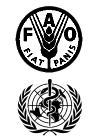
Food Security and Safety
Food safety versus food security
In Wikipedia the topic on "food security" starts with the message Not to be confused with Food safety
. It describes the term as Food security is a measure of the availability of food and individuals' ability to access it
. In this regard one should be aware that humanity has struggled for thousands of years to produce food to feed the populations. Due to the frequent lack of sufficient food, there was little attention for food safety. People did learn to avoid collecting or growing toxic plants and animals, but hazardous properties of chemicals (e.g. vulcanic arsenic deposits in the soil, or metal waste dumped in medieval bottoms) were not known, and therefore not taken into account. And, as there was also little understanding of microbiological hazards, we can be sure that some foods from earlier days were dangerous for the consumer but being consumed without restrictions.
So, what happened that there was growing interest in food safety? A major driver was the so-called Third Agricultural Revolution (also called: The Green Revolution). This is the set of research technology transfer initiatives occurring between 1950 and the late 1960s, that increased agricultural production worldwide. The initiatives resulted in the adoption of new technologies, including high yielding varieties of plants. It was associated with synthetic fertilizers, pesticides, and controlled water-supply (usually involving irrigation) and newer methods of cultivation, including mechanization. As a result, food stuffs of vegetable or animal origin more than doubled in quantities between the years 1961 and 1985. Now food security became less important; many countries could feed their population and export remaining foods at the same time.
Because of the increasing global trade of food and animal feed in the second half of the twenthieth century, the quality of the food became more important. It is considered not ethical to export food that is rejected in the producing country because of hazardous chemical or biological agents. To avoid that such cases would cause trade conflicts between countries, it was decided that food and feed being traded should comply to a series of standards. These standards should be based on quality criteria, including food safety.
Standards
The concept of quality standards for food did already exist at that time. Some countries had already defined some standards. Most of them were intended to control the overall quality of specific foodstuffs, but also to prevent price competition as by prescribing ingredients it became more difficult to use cheap basic materials e.g. water that was of poor quality. A well known example is Das Reinheitsgebot to control the quality of beer. Although at first only intended for the Bavaria region, it became later German law, and also relevant for brewers outside of Germany. A lesser known series of standards is the Codex Alimentarius Austriacus, which date from the end of the nineteenth century. This collection of standards, guidelines and descriptions can be seen as a model system for the Codex Alimentarius; this organization with members of nearly all nations of the world is now the key system of food safety policy globally.
